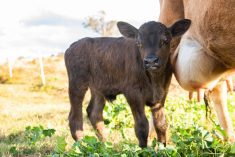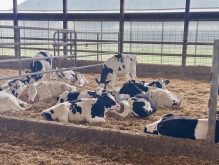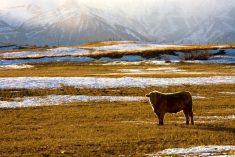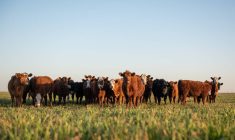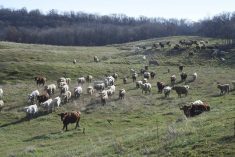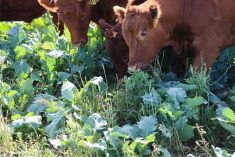That bull has one job — and he might not be doing it.
That’s the message from a recent study out of the Western Beef Development Centre and University of Saskatchewan and the focus of the latest Beef Cattle Research Council webinar.
The research team, including the BCRC’s Stacey Domolewski, used DNA testing to track calf parentage at six different ranches plus the Western Beef Development Centre in Lanigan, Sask.
The results surprised Domolewski. While a certain amount of variability is expected with multiple bulls, often of different ages, her first-year data showed that some bulls were significantly outpacing others. In one pasture, six bulls sired an average 21 calves each, but the most effective of the six sired 53 calves, while one bull sired only five. In another example, a pasture with nine bulls had a top sire with 34 calves, while another bull sired only one.
Read Also

Pig transport stress costs pork sector
Popular livestock trailer designs also increase pig stress during transportation, hitting at meat quality, animal welfare and farm profit, Agriculture and Agri-Food Canada researcher says
“If there’s a sire on your place that’s only producing one or two calves, he’s still costing the same room and board as everybody else there, but he’s not really giving you anything in return,” Domolewski said during the Nov. 16 webinar.
The study created its own bull prolificacy index (BPI) to compare different-size herds. The BPI compared the number of calves expected according to a pasture’s bull-to-cow ratio with the number actually sired. Any BPI over one was considered a more prolific bull than expected, while BPIs less than one marked a flagging bull.
Age effect
There was no real surprise after the first year’s data was analyzed and mature bulls outperformed two-year-old or yearling males. In the second year though, calf crops favoured the two-year-olds.
“Because a bull is older, (it) doesn’t necessarily mean he’s going to sire more calves… there may be a lot of other factors in play here that we’re not looking at,” Domolewski said.
The study also found that a “pass is a pass” in terms of breeding soundness exams. All bulls in the study had passed the exam before the study, but sperm counts had little effect on BPI.
“The bull with the low BPI didn’t have the lowest per cent normal sperm and the bull with the highest BPI didn’t have the highest per cent normal sperm,” Domolewski said.
She was not totally surprised by those results, she said, pointing to previous research where fertility decreased below an exam threshold, but higher than passing grades did not necessarily mean greater fertility.
Simply putting in more bulls may not solve the problem, Domolewski said. The first two years of data showed pastures with more sires also had more varied siring rates.
At the same time, the cost of keeping a non-prolific bull may significantly undercut a farm’s bottom line, she said.
In a cost analysis of low- and high-performing bulls, the study found that a bull purchased for $3,200 and sold after four years will cost the farmer $1,405 per calf to keep if only one calf is sired a year. That number dropped dramatically to $281 per calf if the bull sired five annually and plummeted to $40 per calf at 35 calves sired per year.
The pattern held true when calf quality was brought into account.
“One of the operations that we worked with did follow their calves out to weaning and weighed individual calves, so we have that data for each individual bull. What we found across the board, across all of the breeding pastures, was essentially that the bull that was the highest BPI in the pasture also had the highest total pounds of calf weaned,” Domolewski said.
Investment or cash drain?
Brian Lemon, general manager of the Manitoba Beef Producers, is solidly in favour of beef producers gathering more information on their herd. The idea of tracking calf parentage has not raised any concerns that he’s aware of and he says MBP sees distinct advantages in a more informed breeding program, including better ability to tap into hybrid vigour. He also expects the practice to grow as more producers are swayed by the promised benefits.
At the same time, he said, most producers tracking breeding strategies are not taking it to the level of DNA testing.
“As we move forward, it’s like any new technology, any new innovation,” he said. “You’re always going to have your early adopters that jump on board, but if you’re looking for broad acceptance and broad uptake, it takes a little bit of time to get those folks who are maybe on the fence watching, to get them to come down off the fence and actually implement it and make those investments.”
But while advocates have tapped the practice for a number of advantages (dealing with hoof problems, maximized breeding efficiency and eliminating dystocia among them), producers are still waiting to hear how DNA testing plays out on the balance sheet.
Domolewski dug into the economics of the practice in the hopes of answering some of those questions.
She compared the cost of calf loss due to dystocia to DNA testing expense, also exploring possible shortcuts for producers to access testing advantages while minimizing cost.
A producer might test only calves from difficult births in the hope of eliminating dystocia, Domolewski argued.
She posed the scenario of four bulls in a 100-cow pasture. Of those, she said, assume that 13 births are hard pulls, after which three of those calves die. At $12 a test, a figure the centre says is reasonable considering its own forays into DNA tracking, tests from the 13 hard pulls will cost the farmer $156, combined with the $48 to get four bulls tested for a total $204. In comparison, the loss of three calves at an eventual 510 pounds each and $1.80 a pound would cost the farmer almost $2,800.
“If you could cull the bull that’s causing the problem and prevent that loss in the future, it was pretty simple to say that the test paid for itself,” she said.
The scenario did not include costs a producer might have from that calf before sale.
Early sampling
Calves born in the first 21 days of calving season may also provide a reliable cross-section, rather than testing the parentage of every calf. Although there were some outliers, the study generally found that BPI results stayed in the same range for each bull, regardless of if data was taken from calves born in the first 21 days of the season or from the entire calf crop.
Result turnaround would also drop with fewer tests, Domolewski noted, opening a bigger window for management decisions.
The three-year study is still waiting on its third year of data, collected this year.
The Western Beef Development Centre also has an electronic herdsire cost calculator available to farmers.








